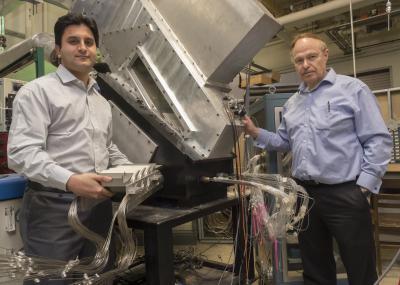A more accurate and successful, yet complex approach used in designing an airplane is now taking off in the health care industry. The end result is helping patients with pulmonary disorders breathe easier, as well as their surgeons in considering novel treatment approaches. Goutham Mylavarapu, a senior research associate in the University of Cincinnati Department of Aerospace Engineering, and Ephraim Gutmark, Ohio Eminent Scholar and UC distinguished professor of aerospace engineering and engineering mechanics, will present their research involving Computational Fluid Dynamics at the 39th American Institute of Aeronautics and Astronautics (AIAA) Dayton-Cincinnati Aerospace Sciences Symposium. The symposium takes place on Wednesday, March 5, in Dayton, Ohio.
Computational Fluid Dynamics, or CFD, uses computer algorithms to solve the flow of air or fluids for various applications. These algorithms are typically applied toward the design of aircraft as they quantify the contribution of airflow to flight requirements. While designing an aircraft, CFD is often considered both an accurate and less expensive approach before investing in building models and testing in air tunnels.
But over the past decade or so, the application of CFD to biological flows to study medically-related problems, including respiratory disorders has gained a great deal of interest. The computer simulations traditionally used for aircraft design found use in treating health conditions such as cystic fibrosis, asthma, sleep apnea and snoring.
The respiratory tract is a pathway of hard and soft structures that take in and push out airflow. Mylavarapu explains that a number of pulmonary upper airway disorders are associated with the vibration and/or deformation of the soft structures around the airway, leading to partial or complete collapse of the airway, as in the case of sleep apnea. In the more severe cases, these airway obstructions or deformations significantly impact quality of life and can even lead to death.

This image shows Goutham Mylavarapu, left, and Ephraim Gutmark.
(Photo Credit: Jay Yocis)
The researchers are using CFD simulations – the most commonly used in the aerospace industry – on actual medical data from patients with breathing disorders. Applying the equations to analyze the information they're seeing in an MRI can provide surgeons with a better idea on how to treat the problem, increasing the success of any surgical approach as well as reducing the number of surgeries (and therefore a better recovery and less of a medical expense) for the patient.
"Historically, the evaluation of a patient's airway is limited to clinical diagnosis with medical imaging," explains Mylavarapu. "But the variability and complexity in the airway anatomy can limit the success rate of surgery. CFD provides a better understanding of respiratory flow and enables individualized treatment when applied to what we're seeing with medical imaging."
"Surgery is sometimes based on experience-based intuition, and it's not always guaranteed that the end result will be effective," says Gutmark. "CFD is another tool to provide surgeons with more quantitative information about the possible outcome during the planning of a surgical procedure."
The researchers are using CFD to examine both the flow and structure equations of the respiratory challenges of individual patients. They also applied the method to a virtual surgery involving a medical case in Sweden, leading to a successful outcome for the patient.
Source: University of Cincinnati